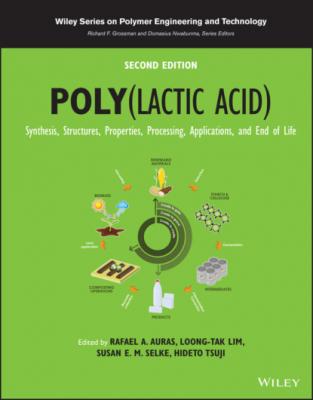Poly(lactic acid). Группа авторов
Читать онлайн.| Название | Poly(lactic acid) |
|---|---|
| Автор произведения | Группа авторов |
| Жанр | Химия |
| Серия | |
| Издательство | Химия |
| Год выпуска | 0 |
| isbn | 9781119767466 |
Lately, attention has been paid to improving the melt crystallizability of sc‐PLA to expand its applications, particularly in industries where melt processing of polymers is employed. The boundary viscosity average molecular weight (
5.3 CRYSTAL STRUCTURE OF sc‐PLA
sc‐PLA often crystallizes in a triclinic or trigonal unit cell with both 31 (or 31 and 32) PLLA and PDLA chains packed side by side [30] unlike the orthorhombic or pseudo‐orthorhombic crystal forms of hc‐PLA [31]. The crystal structure consisting of a triclinic unit cell (P1 symmetry with parallel chain orientation) was proposed in 1991 by Okihara et al., who reported a 31 helical structure of PLLA and PDLA chains having a lamellar thickness of 0.87 nm, where the three enantiomeric chains penetrate one unit cell [32]. The unit cell parameters of a triclinic cell are given as a = b = 9.16 Å, c = 8.7 Å; α = β = 109.2°, γ = 109.8°. The structure was different from that of the trigonal unit cell (R3c or R‐3C group) described by Cartier et al., where the PLLA and PDLA chains have 32 and 31 conformations, respectively [33]. According to the modified trigonal structure, the triclinic cell was assumed to be a subcell of the larger trigonal cell where six helices penetrate one unit cell. The trigonal unit cell parameters may be given as a = b = 14.98 Å, c = 8.7 Å; α = β = 90°, γ = 120°. The crystal was grown from non‐equimolar blends of PLLA and PDLA, which indicated that the co‐crystallization of PLLA and PDLA chains could occur from their asymmetric ratio. However, the proposed model only took 1 : 1 PLLA and PDLA ratio into consideration. Stereocomplex structures with parallel and antiparallel orientation of the molecular chains were studied by molecular simulations by Brizzolara et al. who revealed that the parallel structure (P1) is more stable than the antiparallel structure (P/1). The structures were considered to be triclinic having cell parameters a = 0.912, b = 0.913, c = 0.930 nm, α = β = 110°, γ = 109° for the parallel structure (P1); and a = 0.930, b = 0.940, c = 0.930 nm, α = 111°, β = 112°, γ = 108° for the antiparallel structure (P/1). The growth mechanism of the triangular lamellar crystals in the sc formation was well supported by the molecular simulations [34]. Highly oriented stereocomplex samples were prepared in a study by Sawai et al. who adopted solvent casting technique to prepare the blend films followed by co‐extrusion of the dried polymer blend (draw ratio = 14). The oriented samples showed 20 wide angle X‐ray reflections that were reasonably indexed with a trigonal unit cell as proposed by Cartier et al. with a slight variation of the parameters, which were given as: a = b = 1.50, c = 0.823 nm, α = β = 90 and γ = 120° with R3c space group [35].
These structure models are proposed mainly for the PLLA/PDLA blend having a ratio of 50/50. However, stereocomplexation is also evident in PLLA/PDLA blends having the compositions of 30/70–70/30, for which a new structure model (space group P3) has been proposed by Tashiro et al. [36] on the basis of X‐ray diffraction analysis. According to their model, the co‐existence of PLLA and PDLA chains between the sc crystal lattice is profound for the PLLA/PDLA blend ratios in the range of 30/70–50/50–70/30. Beyond this range, the coexistence of PLLA and PDLA chains is not realizable due to their instability. A statistically disordered packing of PLLA and PDLA chains can be attributed to the P3 space group, unlike the symmetrical R3c model [36, 37]. The unit cell parameters reported by several researchers are tabulated in Table 5.1.
5.4 FORMATION OF STEREOBLOCK PLA
The stereoblock (sb) formation allows for the intermolecular and intramolecular mixing of the neighbouring L‐ and D‐stereosequences, thereby leading to the preferential formation of sc crystallites. This is particularly important when synthesizing sc polymers of HMW. Block copolymerization has received enormous recognition in achieving the desired properties of the resulting materials. The composition of PLLA/PDLA, along with the number of blocks and chain length, can be varied to obtain a variety of diblock and multiblock copolymers with tailored
